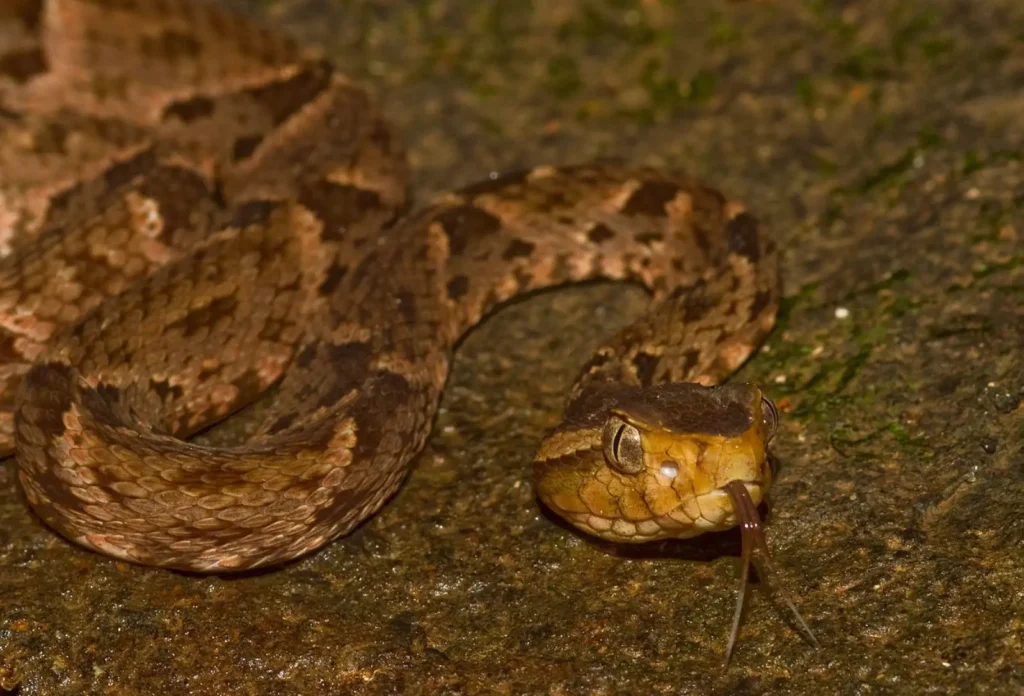
Bothrops lanceolatus
Latin name: Bothrops lanceolatus
Short name: Both
Common name: Fer-de-lance | Yellow Viper | Martinique Lancehead | Spearhead Viper
Primary miasm: Syphilitic
Kingdom: Animals
Family: Viperidae
- Symptomatology
- Remedy Information
- Differentiation & Application
Prepared from the venom of the Bothrops lanceolatus, a highly venomous pit viper native to Martinique and nearby Caribbean islands. The snake’s venom contains potent procoagulant enzymes and tissue-destroying toxins, producing both local necrosis and systemic vascular effects. In crude form, the bite is often fatal due to extensive thrombosis, haemorrhage, and circulatory collapse. The homeopathic remedy is prepared by serial trituration and dilution of the venom to remove toxicity while retaining dynamic action.
None in orthodox medicine, except in the production of antivenom and in toxicological studies.
Pathogenetic data comes primarily from toxicological observations and clinical application by homeopathic physicians, notably in cerebrovascular and thrombotic conditions, rather than from formal Hahnemannian provings.
- Blood & Vascular System: Venous and arterial thrombosis, coagulopathy.
- Nervous System: Paralysis, especially following haemorrhage or thrombosis.
- Cerebrovascular System: Apoplexy, hemiplegia, speech loss from vascular obstruction.
- Eyes: Retinal haemorrhages, visual disturbance from vascular congestion.
- Skin & Tissues: Ecchymosis, gangrene, necrosis.
- Heart: Cardiac weakness from circulatory toxin load.
- Absolute rest; avoiding movement which aggravates haemorrhagic or thrombotic symptoms.
- Lying still, especially on the unaffected side in hemiplegia.
- Pressure over the affected vein in local thrombosis.
- Motion — increases risk of clot dislodgement and haemorrhage [Hering].
- Letting the limb hang down (venous engorgement worsens pain and swelling).
- Warmth of bed in septic conditions — intensifies burning pains.
- Cold damp weather, which aggravates sluggish circulation.
- Lachesis mutus – More loquacity, extreme left-sidedness, aggravation after sleep; Bothrops more paralytic and thrombophilic.
- Crotalus horridus – More haemorrhagic dissolution of blood with jaundice; Bothrops stronger for local phlebitis and cerebral thrombosis.
- Vipera berus – Marked aggravation from hanging down the limb; Bothrops more generalised thrombotic tendency.
- Complementary: Vipera, Crotalus cascavella in septic vascular states.
- Antidotes: Alcohol in crude venom poisoning (emergency use); homeopathically, Lachesis may antidote.
- Follows well: After Arnica in head injury when paralysis remains from clot formation.
Bothrops embodies the dark, obstructive, clot-forming poison that halts the life-flow in veins and arteries, leading to paralysis, gangrene, and death. The homeopathic picture is dominated by thrombosis, phlebitis, apoplexy with aphasia, and purplish skin changes. The patient is sluggish, weak, and fearful of moving, with a deep toxic state pervading the system.
- Indispensable in post-stroke paralysis with aphasia.
- Highly effective in preventing extension of thrombosis in deep vein inflammation.
- Use in septic puerperal thrombophlebitis when limb is swollen, tense, dark.
- Often prescribed in 6C to 30C potencies, repeated cautiously in acute danger.
Mind:
- Delirium, muttering.
- Fear of death at night.
- Confusion, intoxicated feeling.
- Memory loss after apoplexy.
Head:
- Apoplexy, with aphasia.
- Congestion of brain, with vertigo.
- Paralysis after cerebral haemorrhage.
Eyes:
- Haemorrhage into retina.
- Diplopia after stroke.
Stomach:
- Nausea during septic states.
- Vomiting of dark blood.
Skin:
- Ecchymosis, purplish blotches.
- Gangrene of limbs.
- Skin cold, clammy.
Extremities:
- Phlebitis, limb swollen, tense.
- Paralysis, one-sided.
- Trembling after apoplexy.
Generalities:
- Thrombosis tendency.
- Septic states with low fever.
- Worse from motion.
Clarke J.H. – A Dictionary of Practical Materia Medica: Toxicological basis, paralysis, thrombosis.
Hering C. – The Guiding Symptoms: Venous inflammation, septic fevers, paralysis.
Allen T.F. – Encyclopedia of Pure Materia Medica: Collected toxic and clinical records.
Hughes R. – Manual of Pharmacodynamics: Venom pathology, circulatory effects.
Kent J.T. – Lectures on Materia Medica: Aphasia and paralysis indications.
Farrington E.A. – Clinical Materia Medica: Differentiation from other snake remedies.
Lippe A. von – Keynotes: Thrombotic sphere.
Boericke W. – Pocket Manual: Summary uses in apoplexy and thrombosis.
Boger C.M. – Synoptic Key: Paralysis from vascular cause.
Nash E.B. – Leaders in Therapeutics: Acute vascular obstruction.
